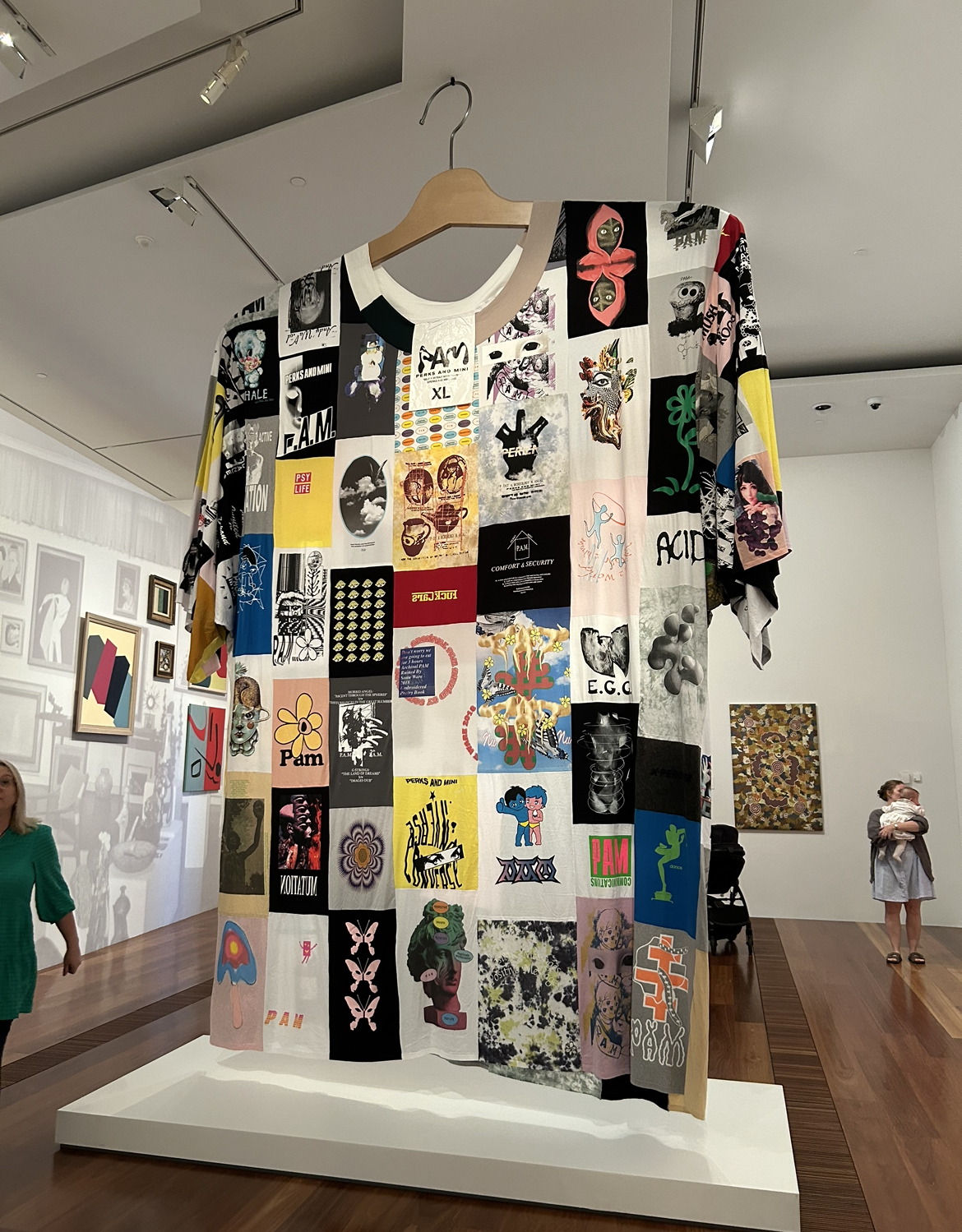Melbourne Now by Cameron Hurst
Cameron Hurst
Here’s a Naarm tale as old as time: When I moved to the city in 2017, I bought a Perks and Mini (P.A.M.) shirt at the second-hand clothes shop Goodbyes (then Recycle Boutique). It was a white cotton tee and featured a couple of black, Matissean graphic figures wobbling around. Crucially, the word “MUTATION” was printed in black lettering below the figures, which added an edgy, transhumanist element to an otherwise fairly mundane tee. I loved this shirt and wore it everywhere. To work, to the club, to my uni classes, to bed. Just like that, I had MUTATED—from a normal girl from the Perth suburbs to a P.A.M.-card-carrying Melbournite. A few years later, the shirt disappeared during a break-up. My ex-boyfriend said he didn’t know where it had gone. I didn’t necessarily believe him, but I accepted the loss graciously. The shirt wasn’t quite as cool as it had once been. It was a bit…Melbourne Then.

At Melbourne Now, one hundred P.A.M. t-shirts, sewn together to form one oversized iteration, hang from the ceiling of the Joseph Brown Collection section of the NGV. The designers, Misha Hollenbach and Shauna Toohey, created the work, Self portrait with t-shirts (2022), using garments from their personal archive. It indexes two decades of global graphic tee market leadership (a Melbourne speciality). One key experience of Melbourne Now is hearing older generations rehash gossip from the 2013 edition. My ageing Memo co-editors informed me of a major P.A.M. broigus last time round that culminated in the label being accused of culturally appropriating non-Western iconography. If you want to relive the discourse, here is your chance. Perhaps my MUTATION tee wasn’t as dope as it seemed at the time of purchase. Perhaps I was complicit in, as the protestors said, an elaborate web of “elitist bullshit” purveyed by people who were “just so bored of being white.” Damn.

This t-shirt anecdote is one example of how meanings attached to the detritus of cultural activity in a city shift (or mutate…) over time. Archiving trajectories like this is presumably the raison d’etre of Melbourne Now. But all this I was yet to contemplate as I wandered the cavernous halls of the 2023 edition. Instead, the P.A.M. shirt and much else prompted me to think: this exhibition makes the NGV seem like a monstrously hungry art consumer who, when seeing an artwork it likes, requests either a supersized version or 50 to 100 more. (Of course, Melbourne supersized art is still relatively modest in comparison to international biennale behemoths.) At the media preview, curator Myles Russell-Cook prompted artist Troy Emery to reflect on how his prowling pom-pom feline was his biggest sculptural work yet. The wall label for Christopher Day’s woozy palimpsest notes that the inclusion is the artist’s “largest photo collage to date.” One can imagine using the NGV International’s lovely collections of British and Japanese crockery for domestic activities. Not so with the Jurassic Melbourne Now “Vessels.” And the catalogue notes that James Lemon’s “takeover” is a first for the artist “in both its scale and interdisciplinarity.” Lemon, beloved for his quirkily glazed ceramic blobs (very now), has created an ultraviolet installation that encourages attendees to imagine life as a bee.

In his review of the show, the art historian Sasha Grishin argues that “although each of these works is spectacular and packs a considerable wow factor, they cannot be dismissed as purely hedonistic eye candy designed as an escapist parachute out of reality.” But isn’t that the point, Professor? The desired effect is white cube sublime. Why else would the NGV so constantly avow the importance of pumped-up size? To be fair, scalability can be a good test of whether an artist can transition from the small stage of an artist-run gallery to the arena of Fed Square. Some of the better works included are by artists who expanded to the occasion in a way that didn’t seem completely arbitrary.
Amalia Lindo’s Telltale: Economies of Time (2022–23) is a more impressive version of a four-screen work shown at the Spring1883 art fair in 2021. Here, we step into a panopticon-like structure of twelve vertical screens attached to steel beams. The screens show videos gathered using MTurk, an Amazon-owned task outsourcing platform (think AirTasker for menial computer jobs). Lindo commissioned over 1,500 workers to submit short videos of their surroundings, responding to a previous worker’s contribution. There is the flash of a sign written in Hindi, tropical foliage, a bangled, wedding-ringed hand reaching through a grate towards a terracotta-washed wall. Honking horns sound. The result is a voyeuristic representation of a dispersed, anonymous (un-unionisable?) labour force linked by invisible networks. Workers of the world send vids?

Lou Hubbard’s Walkers with Dinosaurs (2021–23) made me laugh at death—it’s great. Hundreds of inflated plastic Zimmer frames form a gigantic silver and pharmaceutical-blue pile observed by teethy plastic dinosaur chairs. Some walkers had begun to haemorrhage air (there were perhaps more withered frames than I would expect at this early stage). The work is reminiscent of the NGV’s iconic-ish set of Ron Mueck skulls; both are memento mori. But while Mueck’s chalky domes suffer from blockbuster bathos, Hubbard’s mountain of walkers is ambiguous. The bodily fragility implied by the aid apparatus is undercut by the boisterousness of the ballooning plastic. Epic scale is deflated in real time. Melbourne Now is not all hot air, after all.
Cameron Hurst is a contributing editor of Memo.